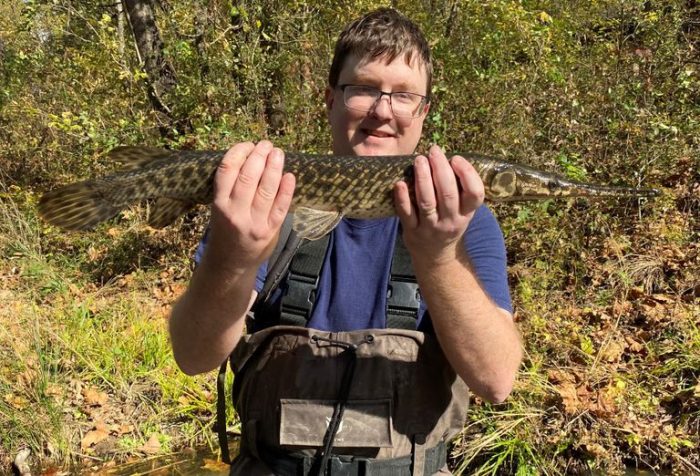
My favorite place is standing in the middle of a stream quietly observing the life around me. There is something special about streams. They have stable habitat features, but these features are also constantly changing every second, every season and every year.
Bjorn Schmidt, Ph.D. Assistant Professor
- Faculty

Growing up in North Florida, Dr. Bjorn Schmidt spent his childhood exploring streams and nature. His interest in fish research grew following his undergraduate work. Schmidt has been hooked on fish ecology since catching a paddlefish—an amazing species to hold and observe up close—on a sampling project in the Red River of Louisiana. He is happiest when exploring the diverse species groups present in the lakes and rivers of North America and Asia.
His passion for fish conservation and understanding how humans are impacting aquatic communities drives Schmidt to investigate solutions for ecologically sound, sustainable growth in situations with complex water demands or needs.
A Conversation with Dr. Schmidt
What would you tell a student who is considering A&M-Commerce?
We are truly a student-focused organization, with smaller class sizes allowing for better interaction between faculty and students. There are many opportunities for undergraduates to get involved with research at the school, gaining valuable experience for their careers. Our goal at A&M-Commerce is to transform lives through our mission to “Educate. Discover. Achieve.” Our faculty are committed to transforming lives by sharing their passion and expertise for the subjects they research and teach, providing avenues for students to experience personal and professional growth. A&M-Commerce is close to the Dallas-Fort Worth metroplex and, therefore, can offer an urban or rural experience that can be tailored to students' preferences and needs.
What draws you to your discipline?
My favorite place is standing in the middle of a stream quietly observing the life around me. There is something special about streams. They have stable habitat features, but these features are also constantly changing every second, every season and every year. If you revisit a stream 10 years later, it may look the same with the same habitat features, but the specific details for those features may be different. A section of stream may still have riffles and pools, but the exact placement of the riffle-pool sequence may have shifted due to the specific history of flow events in that system. I am drawn to these systems because they are both stable and dynamic, which can lead to some interesting population and community patterns. Freshwater environments are also some of the most at-risk ecosystems with increasing human populations, especially in areas with periodic droughts such as North Texas. My research mainly focuses on how human impacts affect aquatic populations and communities, and looks to provide insight to guide conservation management of rare species and guide sustainable growth and land use in relation to impacts on freshwater communities. My research often draws on concepts from landscape ecology and population genetics to investigate these patterns.
Tell us about a project you are currently working on or recently completed.
I recently investigated invasion and range expansion in storage lakes connected by a large-scale water diversion in Asia. Three fish species had expanded distributions in the system, driven by water diversion practices. We conducted genetic analysis on lake populations to understand and model patterns of non-native spread. An interesting result was that specific ecological differences in the species led to differing patterns of spread when colonizing new lake populations. Genetic analysis showed that two species that had buoyant eggs and longer larval stages had a cascading pattern of spread in the system, meaning downstream populations had genetic sources from all upstream points in the system. This indicated that the spread for these species was mainly caused by the movement of early life stages that could deposit or move through lakes in a cascading pattern.
The species that had comparatively reduced larval duration mainly spread in a stepwise manner, with genetic sources of new populations being the immediate upstream neighbor, which indicated a more limited larval transport or adult movement in the system. This project can allow for a better understanding of the risks involved in systems connected by water diversion that house different communities. Specifically, this research shows how specific traits of potentially invasive species, including patterns of early life history, can be compared, which can provide guidance for water managers to avoid seasonal diversion times that would cause unintentional spread of larvae during reproductive seasons of problematic species.
Educational Background
- Ph.D., Biology, The University of Southern Mississippi, 2016
- M.S., Biology, Western Kentucky University, 2009
- B.S., Ecology and Evolutionary Biology, Tulane University, 2003
Awards and Honors
- Student Organization Advisor of the Year, Texas A&M University-Commerce, 2022-23
Research Interests
- Aquatic ecology
- Population genetics
- Conservation genetics
- Invasive species
Professional Organizations
Selected Publications
Related News

A&M-Commerce Researcher Joins East Texas Conservation Project
A&M-Commerce assistant professor of biology Dr. Bjorn Schmidt secured a grant for $20,240.52 to participate in a collaborative research project between Texas Parks & Wildlife and Stephen F. Austin University. The joint venture will investigate the distribution of several rare fish species with the greatest conservation needs in East Texas. A&M-Commerce researchers will collect water […]


